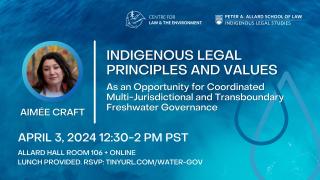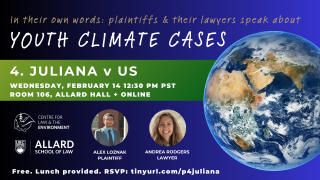Aristotle, David Attenborough, and the Paris Agreement: Lessons in Climate Rhetoric

Lara Solie
Allard JD Candidate 2024
Feb 7, 2023
Aristotle proposed that there are three key elements of persuasion: logos (logic and evidence), ethos (reputation and authority) and pathos (emotions and method of delivery). In the public sphere, science and facts frequently become directly intertwined with emotions and psychology. The science of climate change, and the process of taking climate action, are no exception.
Recently, the Guardian revealed that the idea of the “carbon footprint” was invented by an advertising firm working for the oil company British Petroleum. The concept was created to shift the responsibility for climate change from fossil fuel companies to individuals, when in fact the former cause far more damage. Yet, just as wartime propaganda poster techniques swayed people’s hearts, the carbon footprint spurred people to examine their own behaviour. For whatever purpose it is used, rhetoric is undeniably a powerful tool.
Individuals are generally more likely to believe information that comes from a source of ethos—such as a well-respected governmental entity or organization. Individuals are also more willing to believe information that confirms what they want to believe. A belief that the world is “orderly, predictable, and just” is cherished by many, but is fundamentally disrupted by the notion of climate disaster. The resulting discomfort, and resistance towards that discomfort, is one reason why the language used to communicate the climate crisis is crucially important. In order to convey its urgency and drive action in the right direction, information must be relayed thoughtfully and strategically.
The documentary “David Attenborough: A Life on Our Planet” was released in 2020 alongside its companion book, “A Life on Our Planet: My Witness Statement and a Vision for the Future”. Both were received with overwhelming praise. They describe the world as a beautiful and wondrous place, and in turn describe the climate crisis as humankind’s “greatest mistake”. They do not shy away from illustrating the current consequences of climate change. They call attention to the catastrophic ramifications that will soon occur if the status quo is maintained. They rouse distress, and fear. Yet, they end with a reassuring dose of optimism, and inform their audience that it is not too late… as long as we have the will to take action.
The rhetoric used to convey facts can be as impactful as the facts themselves. Research has shown that barriers to climate action are commonly psychological, and include “lack of knowledge, uncertainty and skepticism, distrust in information sources, externalization of responsibility and blame, belief in technology, belief that climate change is a distant threat, reluctance to change lifestyles, fatalism, feeling helpless, social norms…,” etcetera. Research has additionally shown that an effective climate action strategy is one that comes from a credible source, articulates the true severity of the impending threat, outlines the specific and attainable actions needed to address that threat, and provides convincing information about the benefits that come with addressing it. In order for that strategy to do any of those things, it needs rhetoric.
How does this relate to law? To answer this, you need only look at the limitations of the documentary and book duo. They exemplify the type of rhetoric that is effective in conveying the realities of the climate crisis, and the urgency required in combating it. They are scolding, but inspiring. They are personal, but logical. Yet, as works of pop-culture media, they contain no legislative or law-making power. Their power is restricted to their cultural impact, but their reach is also limited to the audiences who choose to engage with them.
These limitations can be contrasted with the strengths of the 2015 Paris Agreement on climate change. Renowned as an act of international solidarity and a collective acknowledgement of climate change, The Agreement is a legislative milestone in pursuit of climate action.
Unfortunately, it comes with its own limitations. Its ambitious goals are contradicted by the lackadaisical efforts of its parties. Despite being legally binding, its absence of financial incentives, and of penalties, dramatically lower the benefits of compliance, and the costs of non-compliance. Unlike the aforementioned media, The Agreement does not expose the realities of what will happen if climate change is to continue its course. Instead, it relies on vague, idealistic goals like keeping global average temperature increases “well below 2°C” and developing climate-saving technologies that do not yet exist. The Agreement tiptoes around the direness of the issue, calling climate change an “impact”, and an “adverse effect”, while the word “urgent” appears only twice, and words like “crisis” and “disaster” are avoided completely. At the same time, it deploys grand phrases such as “ambitious efforts”, and “environmental integrity,” but does little to enforce them. It portrays climate change as something that can be comfortably tied up in a bow, and leaves too much space for inaction.
To its credit, it is possible that these factors—its use of non-provocative language and its allowance for low-stakes participation—are precisely what led to its success in achieving a rare consensus of 195 countries. Nevertheless, it still has not been successful enough in achieving its goals.
On a structural level, critics have asserted that it is entirely possible to implement the types of changes needed to overcome its limitations. The real question is how to successfully communicate the implementation of those changes—and the overall message—in a way that is effective and maintains participation to the highest degree possible. Law, just like science, cannot divorce itself from emotions and psychology; we see this played out daily in courtrooms, in negotiations, in interpretations of words and provisions. It makes sense that effective terms must become intertwined with effective rhetoric.
Perhaps, then, the Paris Agreement should take a page from the works of David Attenborough. It needs to inform, alarm, and motivate its reader. The benefits of this are twofold. The Agreement’s status as an apex source of ethos means that it is in an optimal position to generate tangible action amongst lawmakers, while simultaneously disseminating widespread public awareness. The Agreement is more than just a treaty, it is also a cultural statement. Law is often shaped by culture, and culture is often shaped by law; the effect is mutual and cyclical.
It is a concern that implementing the changes necessary to overcome the limitations of The Agreement may result in parties withdrawing—regardless of how those changes are communicated. However, the status quo is not working. The globe is still warming, and the Earth continues on its course towards environmental devastation.
The status quo is not working in part because people find it is hard to digest the truth that the climate crisis cannot be addressed in a way that is comfortable or subtle. Effective solutions will be uncomfortable and drastic. Addressing climate change involves persuading parties to act against short-term interests for the sake of long-term benefits. For this purpose, rhetoric is an invaluable tool. In order for a legal document like the Paris Agreement to succeed, it must include effective stipulations, but it must also be rhetorically effective. An added focus on rhetoric embraces, as opposed to ignores, the role played by emotions in changemaking. For a wicked problem like climate change, we need to do more than understand the science and apply the law. We need to also understand the psychology of emotion, the art of language, and use those understandings to positively influence behaviour. Science is our logos, the law is our ethos, and effective communication is our pathos.
- Centre for Law and the Environment


